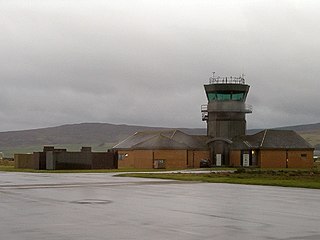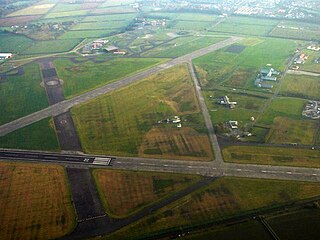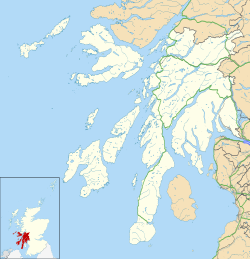
Royal Air Force Machrihanish or RAF Machrihanish is a former Royal Air Force station located near the town of Machrihanish and 3.5 miles (5.6 km) west of Campbeltown, at the tip of the Kintyre peninsula, Argyll and Bute, in Scotland.

Campbeltown Airport is located at Machrihanish, 3 nautical miles west of Campbeltown, near the tip of the Kintyre peninsula in Argyll and Bute on the west coast of Scotland.
Royal Air Force Manston or more simply RAF Manston is a former Royal Air Force station located in the north-east of Kent, at grid reference TR334663 on the Isle of Thanet from 1916 until 1996. The site was split between a commercial airport Kent International Airport (KIA), since closed, and a continuing military use by the Defence Fire Training and Development Centre (DFTDC), following on from a long-standing training facility for RAF firefighters at the RAF Manston base. In March 2017, RAF Manston became the HQ for the 3rd Battalion, Princess of Wales Royal Regiment (PWRR).

Royal Naval Air Station Yeovilton, commonly referred to as RNAS Yeovilton, is a military airbase of the Royal Navy, sited a few miles north of Yeovil, in the English county of Somerset. It is one of two active Fleet Air Arm bases, the other being RNAS Culdrose). RNAS Yeovilton is currently home to the Royal Navy Wildcat HMA2, along with Army Air Corps Wildcat AH1 helicopters, as well as the Royal Navy's Commando Helicopter Force Merlin HCi3/4/4A and Wildcat AH1 helicopters.
835 Naval Air Squadron was a former squadron of the Royal Navy's Fleet Air Arm originally formed in February 1942 as a torpedo bomber and reconnaissance unit flying Fairey Swordfish. In June 1943, six Sea Hurricanes were added to the squadron as a fighter flight. The composite unit exchanged the Hurricanes in September 1944 for Grumman Wildcats, serving on until 1 April 1945, when the squadron disbanded.
Royal Air Force Nutts Corner, or more simply RAF Nutts Corner, is a former Royal Air Force (RAF) station located 2.7 miles (4.3 km) east of Crumlin, County Antrim, Northern Ireland and 9.2 miles (14.8 km) north west of Belfast.

Kirkwall Airport is the main airport serving Orkney in Scotland. It is located 2.5 NM southeast of Kirkwall and is owned by Highlands and Islands Airports Limited. The airport is used by Loganair.
Royal Air Force Heathfield, or more commonly RAF Heathfield, sometimes known as RAF Ayr/Heathfield due to its proximity to Glasgow Prestwick Airport, which was also used by military flights, is a former Royal Air Force station. It opened in April 1941 as an airbase for day and night fighter squadrons. In September 1944 it transferred to Fleet Air Arm control and commissioned as HMS Wagtail. The Royal Navy paid off the airbase in March 1946 and it was reduced to care and maintenance. The United States Air Force used it for storage between 1951 and 1957, with the designation USAAF Station 570.

Royal Naval Air Station Inskip, was a Royal Navy Fleet Air Arm airbase near the village of Inskip, Lancashire, England. It saw considerable aircrew training activity towards the end of the Second World War. In the 1960s and 70s it was a Royal Navy transmitting station known as HMS Inskip. It is now a military high frequency radio transmitting station known as MOD Inskip.

Royal Naval Air Station Hatston, was a Royal Naval Air Station, one mile to the north west of Kirkwall on the island of Mainland, Orkney, Scotland. It was located near the strategically vital naval base of Scapa Flow, which for most of the twentieth century formed the main base of the ships of the Home Fleet. The airbase was designed to provide accommodation for disembarked Front-Line squadrons and accommodation for disembarked Ship's Flight Aircraft and was home to the Home Fleet Fleet Requirements Unit, 771 Naval Air Squadron.

Royal Air Force Ballykelly, or more simply RAF Ballykelly, is a former Royal Air Force station which opened in 1941 in Ballykelly, County Londonderry. It closed in 1971 when the site was handed over to the British Army as Shackleton Barracks. A small part of the base has been used as a refuelling point by army helicopters and small fixed-wing aircraft usually operating out of Joint Helicopter Command Flying Station Aldergrove near the town of Antrim.
730 Naval Air Squadron was a Naval Air Squadron of the Royal Navy's Fleet Air Arm. It was active between 1944 and 1945 as a communications squadron. The squadron was formed and operated out of RNAS Abbotsinch from April to November 1944, by that point in time it operated four types of aircraft. It moved to RNAS Ayr and while there gained two more aircraft types. For the first three months of 1945 a detachment operated out of RNAS Machrihanish, however, the squadron remained at RNAS Ayr until disbanding in August 1945.
740 Naval Air Squadron was a Naval Air Squadron of the Royal Navy's Fleet Air Arm. It was formed in 1943 as an Observer Training Squadron RNAS Arbroath, disbanding the same year. From 1943 to 1945 it was a Communications Squadron based at RNAS Machrihanish.

744 Naval Air Squadron is a Naval Air Squadron of the Royal Navy's Fleet Air Arm. It was initially active in 1943, based in Nova Scotia. A second 744 NAS was formed, in early 1944, in Northern Ireland, for Merchant Aircraft Carrier training, meaning the first iteration was re-designated 754 NAS. The squadron's primary focus turned to Anti-submarine warfare training, which then further developed into trialing new submarine detection technology, ending in 1956. In 2018 it reformed as the Mission Systems and Armament Test and Evaluation Squadron.

751 Naval Air Squadron was a Naval Air Squadron of the Royal Navy's Fleet Air Arm. It was initially active as an Observer Training Squadron from 1939 to 1944 as part of No.1 Observer School. 751 NAS formed at RNAS Ford in May 1939. Ford was attacked and bombed, in August 1940, and the following day the squadron relocated to RNAS Arbroath. Twelve months later it moved to RNAS Dundee, remaining there until disbanding at Dundee in May 1944.

764 Naval Air Squadron was a Naval Air Squadron of the Royal Navy's Fleet Air Arm. It initially formed in April 1940, at RNAS Lee-on-Solent, as an Advance Seaplane training Squadron. The Squadron moved to RAF Pembroke Dock in July 1940, and later to RNAS Lawrenny Ferry, in October 1941 and remaining there until the Squadron disbanded in November 1943. It reformed at RNAS Gosport, in February 1944, as the User Trials Unit, however, the Squadron was decommissioned for the second time in September 1945. 764 NAS reformed again, at RNAS Lossiemouth, in May 1953, where it became an Advanced Training Unit. It moved to RNAS Yeovilton in September 1953, where it received its first jet aircraft. In November 1954 the Squadron disbanded.

766 Naval Air Squadron was a Naval Air Squadron of the Royal Navy's Fleet Air Arm. It was to have initially formed in 1939 at RNAS Lee-on-Solent, as a Seaplane School, however, it formed at RNAS Machrihannish as a Night ALT Course, in 1942. It moved to RNAS Inskip, in 1943, to become part of No. 1 Naval Operational Training Unit. By 1944, it was operating over 30 swordfish aircraft, but, during the year, also acquired Firefly aircraft from 1772 NAS, and Sea Hurricane aircraft from 760 NAS. It moved to RNAS Rattray early in 1946, but later that year, moved to RNAS Lossiemouth where it received Seafire aircraft, along with being Part 1 of the Operational Flying School. By late 1951, Sea Fury trainer aircraft were also added to its varied list of types operated. In 1953, the squadron moved to RNAS Culdrose, where it disbanded in 1954.

768 Naval Air Squadron was a Naval Air Squadron of the Royal Navy's Fleet Air Arm.
790 Naval Air Squadron was a Naval Air Squadron of the Royal Navy's Fleet Air Arm.

Royal Naval Air Station Twatt, is a former Royal Navy Air Station located near Twatt, Orkney, Scotland. It was built by the Admiralty and was commissioned on 1 April 1941. On 1 January 1942 it became an independent command as HMS Tern. The airbase was designed to provide accommodation for disembarked Front-Line squadrons and accommodation for disembarked Ship's Flight Aircraft and was home to the Home Fleet Fleet Requirements Unit, 771 Naval Air Squadron.













